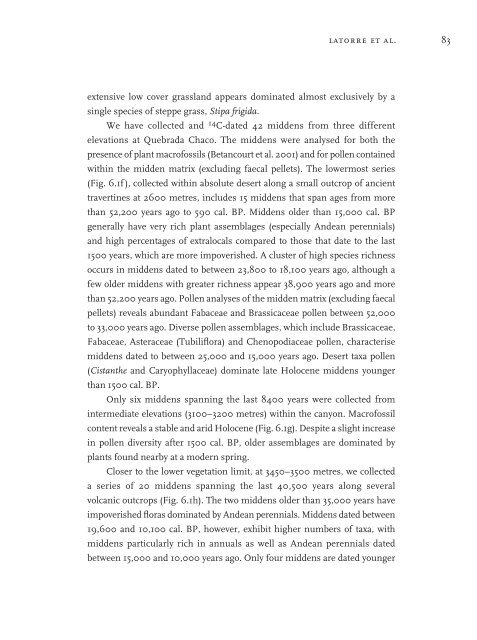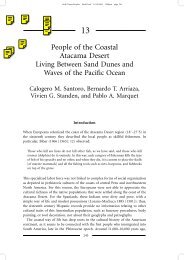Late Quaternary History of the Atacama Desert.
Late Quaternary History of the Atacama Desert.
Late Quaternary History of the Atacama Desert.
You also want an ePaper? Increase the reach of your titles
YUMPU automatically turns print PDFs into web optimized ePapers that Google loves.
latorre et al. 83extensive low cover grassland appears dominated almost exclusively by asingle species <strong>of</strong> steppe grass, Stipa frigida.We have collected and 14 C-dated 42 middens from three differentelevations at Quebrada Chaco. The middens were analysed for both <strong>the</strong>presence <strong>of</strong> plant macr<strong>of</strong>ossils (Betancourt et al. 2001) and for pollen containedwithin <strong>the</strong> midden matrix (excluding faecal pellets). The lowermost series(Fig. 6.1f ), collected within absolute desert along a small outcrop <strong>of</strong> ancienttravertines at 2600 metres, includes 15 middens that span ages from morethan 52,200 years ago to 590 cal. BP. Middens older than 15,000 cal. BPgenerally have very rich plant assemblages (especially Andean perennials)and high percentages <strong>of</strong> extralocals compared to those that date to <strong>the</strong> last1500 years, which are more impoverished. A cluster <strong>of</strong> high species richnessoccurs in middens dated to between 23,800 to 18,100 years ago, although afew older middens with greater richness appear 38,900 years ago and morethan 52,200 years ago. Pollen analyses <strong>of</strong> <strong>the</strong> midden matrix (excluding faecalpellets) reveals abundant Fabaceae and Brassicaceae pollen between 52,000to 33,000 years ago. Diverse pollen assemblages, which include Brassicaceae,Fabaceae, Asteraceae (Tubiliflora) and Chenopodiaceae pollen, characterisemiddens dated to between 25,000 and 15,000 years ago. <strong>Desert</strong> taxa pollen(Cistan<strong>the</strong> and Caryophyllaceae) dominate late Holocene middens youngerthan 1500 cal. BP.Only six middens spanning <strong>the</strong> last 8400 years were collected fromintermediate elevations (3100–3200 metres) within <strong>the</strong> canyon. Macr<strong>of</strong>ossilcontent reveals a stable and arid Holocene (Fig. 6.1g). Despite a slight increasein pollen diversity after 1500 cal. BP, older assemblages are dominated byplants found nearby at a modern spring.Closer to <strong>the</strong> lower vegetation limit, at 3450–3500 metres, we collecteda series <strong>of</strong> 20 middens spanning <strong>the</strong> last 40,500 years along severalvolcanic outcrops (Fig. 6.1h). The two middens older than 35,000 years haveimpoverished floras dominated by Andean perennials. Middens dated between19,600 and 10,100 cal. BP, however, exhibit higher numbers <strong>of</strong> taxa, withmiddens particularly rich in annuals as well as Andean perennials datedbetween 15,000 and 10,000 years ago. Only four middens are dated younger
















